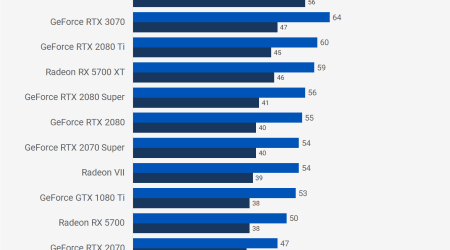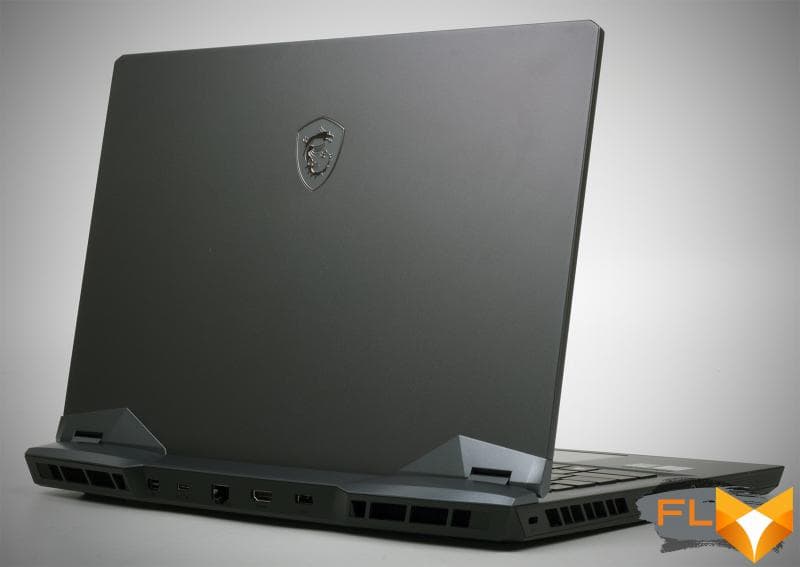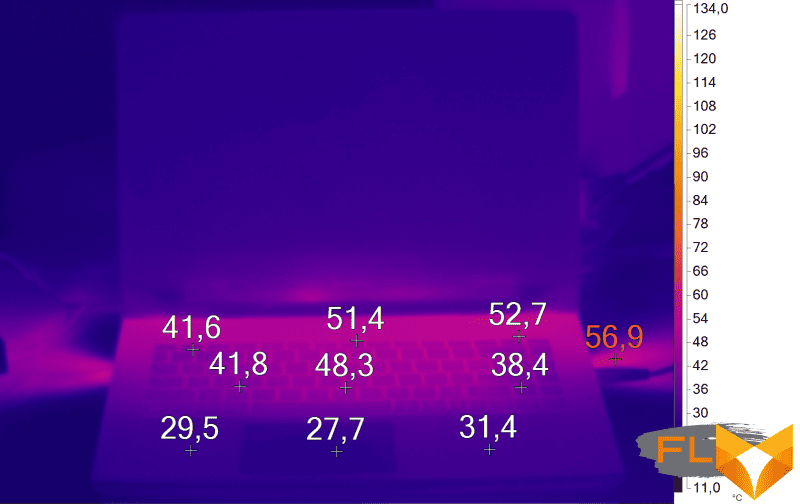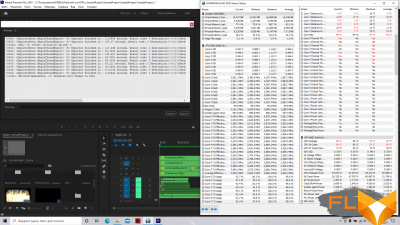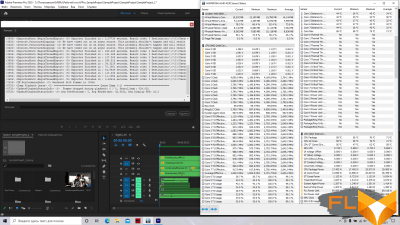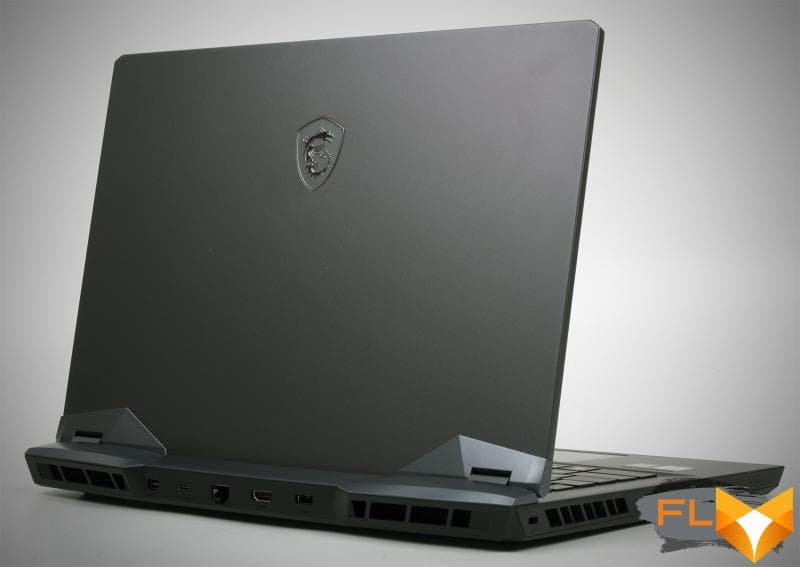


At the end of last year, a review of the MSI GE66 Raider model was already published on our website – then the 10SGS-062RU version, equipped with an 8-core Core i9-10980HK and a GeForce RTX 2080 SUPER in Max-Q design, arrived at our editorial office. The Raider, which we will talk about today, has changed little in appearance, but under the “hood” this version of the GE66 has NVIDIA Ampere mobile graphics. Let’s see how the updated gaming mobile PC has become faster in games.
MSI GE66 Raider (2021)
⇡#Specifications, equipment and software
The official MSI website reports that we will find three MSI GE66 Raider models on sale. In all cases, 8-core Intel Comet Lake processors and GeForce RTX 3070 or RTX 3080 mobile graphics cards are used – to choose from. Other characteristics of the novelty are shown in the table below.
| MSI GE66 Raider (2021) | |
| Primary display | 15.6″, 1920 × 1080, IPS, 240 or 300 Hz 15.6″, 3840 × 2160, IPS |
| CPU | Intel Core i9-10980HK Intel Core i7-10870H |
| Video card | NVIDIA GeForce RTX 3080 16GB NVIDIA GeForce RTX 3070 (130W) 8GB |
| RAM | Up to 64GB DDR4-3200 |
| Install Drives | 2 × M.2 in PCI Express x4 3.0 / SATA 6Gb/s mode |
| Optical drive | None |
| Interfaces | 2 × USB 3.2 Gen1 Type-A 1 x USB 3.2 Gen2 Type-A 1 × USB 3.2 Gen2 Type-C (Shared with DisplayPort) 1 x USB 3.2 Gen2 Type-C 1 x 3.5mm mini jack 1 x RJ-45 1 x HDMI 1 × mini-DisplayPort 1 × card reader |
| Built-in battery | 99.9 Wh |
| External power supply | 230W |
| Dimensions | 358 × 267 × 23.4 mm |
| Notebook weight | 2.38kg |
| Operating system | Windows 10 Home |
| Warranty | 2 years |
| Price | $3,100 for test model |
 |  |
The younger version of the new GE66 Raider (marking – 10UG-418RU) came to us. It has an 8-core Core i7-10870H, 16 GB of DDR4-3200 RAM, a mobile GeForce RTX 3070 and a 512 GB SSD. At the time of writing, such a model could be purchased for $3,100.
Unfortunately, the manufacturer does not indicate the maximum power consumption of the GPU in their laptops, however, we see that we are talking about the most productive version of the GeForce RTX 3070. You can read more about all the features of the new NVIDIA graphics for laptops in the article “Overview of the mobile version of NVIDIA GeForce RTX 3080 : Ampere is now in laptops!
MSI claims that the updated version of GE66 Raider is the world’s first laptop with Wi-Fi 6E wireless module. The computer uses an Intel Wi-Fi 6E AX210 controller that supports IEEE 802.11b/g/n/ac/ax standards at 2.4, 5, and 6 GHz with a maximum throughput of up to 2.4 Gbps and Bluetooth 5.2.
The 2.5-gigabit Killer Ethernet E3100X controller is responsible for the wired network in the laptop.
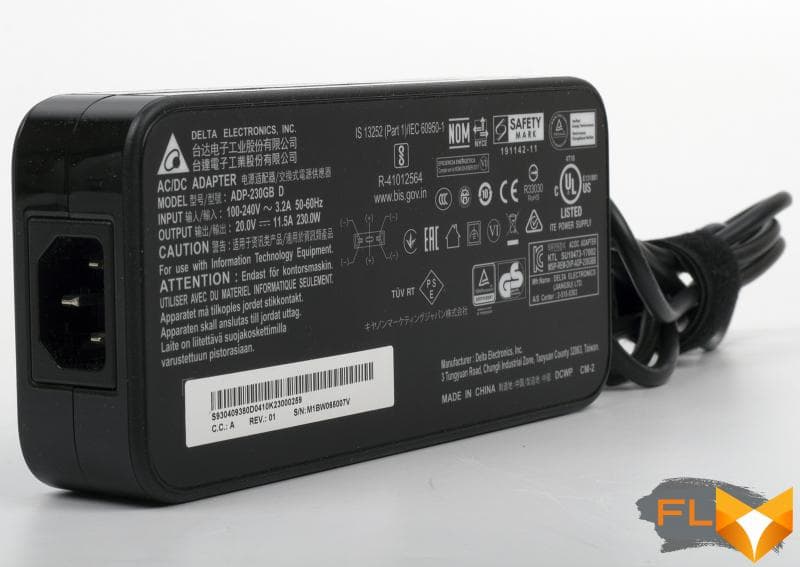
Included with the laptop was a fairly large external power supply with a capacity of 230 watts. Its weight is 700 grams – it will not be very convenient to carry it with you every time. There is no word on support for USB Power Delivery.
⇡#Appearance and Input Devices
Externally, the updated model has not undergone any changes. You look at the GE66 Raider – and persistent associations with sports cars appear, with their bold and aggressive design.
The main part of the body is still made of metal. I have no complaints about the build quality: the test for bending and punching all kinds of surfaces – the keyboard and the display cover – has been passed. The lid, by the way, can be easily opened with one hand, and its maximum opening angle is 140 degrees.
 | 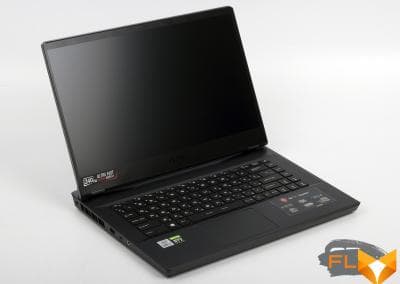 |
The laptop looks compact. The side bezels of the display are only 5 mm wide (the screen occupies 82% of the area of the top cover), and the screen itself is located a little closer to the user than usual. This is achieved through the use of special loops – they position the screen well.
The thickness and weight of the Raider are not record-breaking, as a result, together with an external PSU, you will have to carry a little more than 3 kg of gaming hardware with you in your backpack.
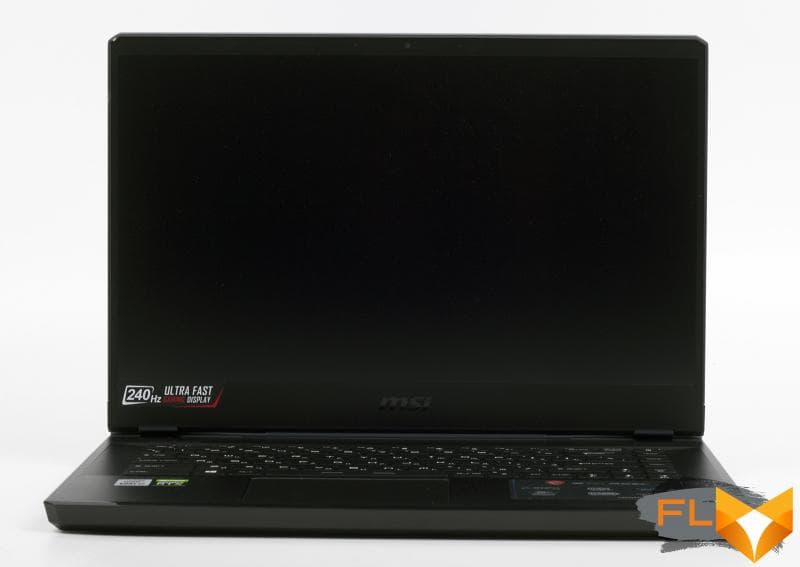
In the review of the 2020 model, I already noted the motto of the GE66 Raider series: “Light it up!” And this word, in my opinion, means not only the advanced gaming equipment of the laptop, but also the bright backlight MYSTIC LIGHT. In a laptop, not only the keyboard glows, but the entire front edge of the case. Naturally, if desired, the backlight can always be turned off.

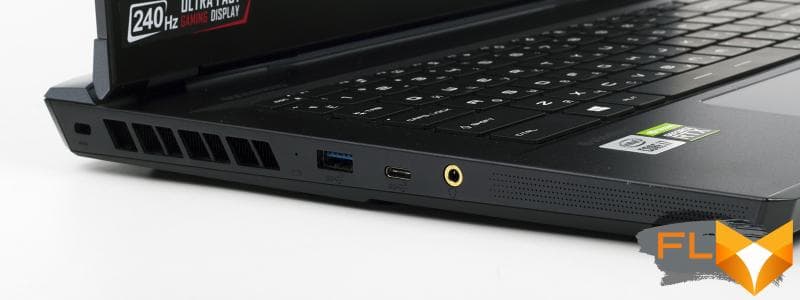
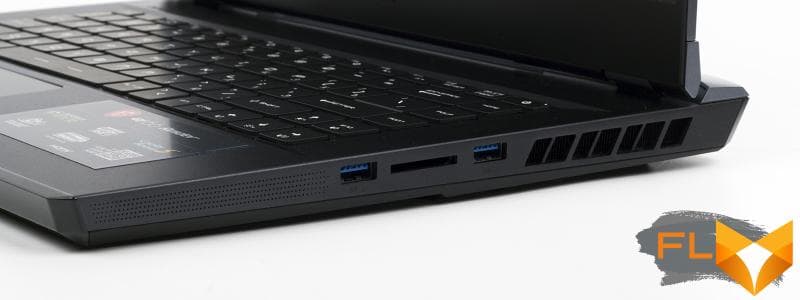
The laptop interfaces are separated on three sides – this arrangement turns out to be very convenient if the laptop is used more often at home and only occasionally moved from place to place. On the back, the GE66 Raider is equipped with mini-DisplayPort and HDMI video outputs, as well as an RJ-45 network port and a USB 3.2 Gen2 C-type connector combined with mini-DisplayPort. There is also a port for connecting the power supply.
On the left of the Raider you will find USB 3.2 Gen2 A- and C-types and a 3.5 mm combo port for connecting a headset, on the right – a couple of USB 3.2 Gen1 A-type and a card reader that supports XC / HC SD cards .
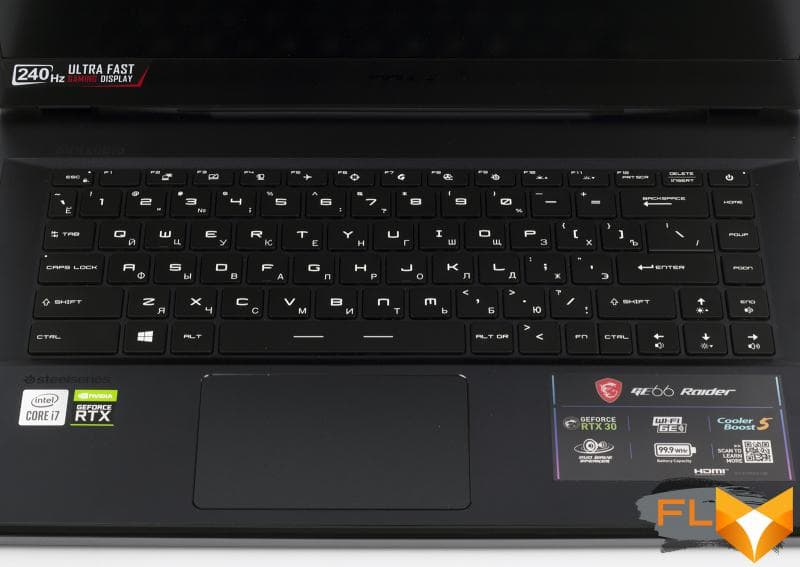
The keyboard in the GE66 Raider has not changed – it is still created in collaboration with SteelSeries. There is (traditionally) no digital block, but playing and typing while sitting at a laptop turns out to be quite convenient. You will only have to get used to the small Fn and right Ctrl, as well as to the location of Home, PgUp, PgDn and End in the rightmost column. Otherwise, the keys suited me perfectly, especially the large Shift, left Ctrl, Enter and Backspace. Pressing any button is smooth, but with a noticeable impact. Typing on the keyboard is pretty quiet.
I also have no special complaints about the touch panel. But in any case, it will be more convenient to play with a mouse.
Finally, MSI should be commended for using a Full HD webcam – many other manufacturers are still installing modules that max out at 720p. The quality of the picture of such a “webcam” is quite enough for video calls even in a shaded room.
⇡#Internal design and upgrade options
I really want modern laptops to be upgraded as easily as possible. After all, when buying an expensive device, you want to be able to extend its “shelf life” in the future by replacing, for example, an SSD with a faster model or by increasing the amount of RAM. Fortunately, the test GE66 Raider is quite easy to disassemble: we unscrew all the screws – and carefully (in order not to leave ugly burrs on the case) we pry off the lower detachable plate with a plastic card.
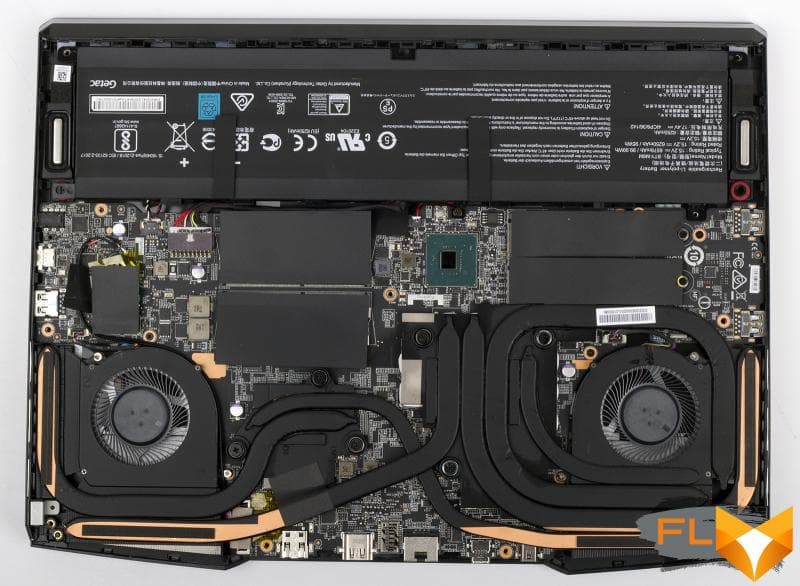
The Raider cooling system consists of six heat pipes of different lengths and shapes, two large copper radiators and a pair of tangential fans. Because of this design, heated air leaves the laptop case not only from the back, but also from the sides.
Externally, the GE66 Raider cooler inspires confidence, but we will definitely test its performance further.
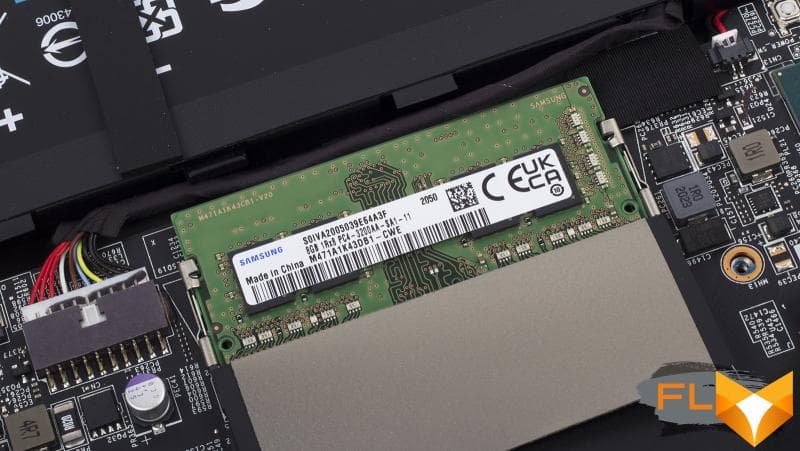
It definitely makes sense to look under the laptop cover some time after the purchase. Firstly, you can install another SSD in a pair with the main drive – not everyone will be satisfied with the initial volume of 512 GB. Secondly, 16 GB of RAM will not always be enough for games, but its volume can be increased.
It turns out that you will have no problems with the GE66 Raider upgrade.
⇡#Test Methodology
The testing methodology for gaming laptops puts even more emphasis on PC gaming. Laptop performance was measured using various software.
Games (Full HD resolution):
- World of Tanks EnCore RT. DirectX 11. Benchmark. Ultra mode, RT off
- Counter Strike: Global Offensive. DirectX 9. FPS Benchmark map. Multi-core processing – incl. Maximum quality.
- The Witcher III: Wild Hunt. DirectX 11. Novigrad and surroundings. Maximum quality.
- GTA V. DirectX 11. Built-in benchmark. Maximum quality, FXAA + 2x MSAA, advanced quality settings on, 16x AF, image resolution scaling off
- PlayerUnknown’s Battlegrounds. DirectX 11. Training mode. Ultra Mode
- Shadow of the Tomb Raider. DirectX 12. Built-in benchmark. Maximum quality, DXR – off, TAA.
- Assassin’s Creed Odyssey. DirectX 11. Built-in benchmark. Highest mode.
- Battlefield V. DirectX 12. The Last Tiger mission. Ultra Mode, TAA, DXR Off
- Red Dead Redemption 2. Vulkan. Built-in benchmark. Maximum quality (advanced settings – off), TAA.
- Gears 5. DirectX 12. Built-in benchmark. Ultra Mode
- Metro: Exodus. DirectX 12. Built-in benchmark. Ultra Mode
- Horizon Zero Dawn. DirectX 12. Built-in benchmark. Top quality, TAA.
- Death Stranding. DirectX 12 Prologue. Maximum quality.
- A Total War Saga: TROY. DirectX 11. Built-in benchmark. Max mode, 4x AA (no AA in Ultra HD).
- DOOM Eternal. Vulcan. Beginning of the game. Absolute Nightmare Mode
- Watch Dogs: Legion. DirectX 12. Built-in benchmark. Maximum quality, TAA, DXR off, DLSS off
- Cyberpunk 2077. DirectX 12. City trip. Impressive quality mode, DXR off, DLSS off
Gaming performance was measured using the well-known CapFrameX program. It allows you to get the rendering time of each frame. The use of the 99th percentile instead of the minimum frames per second is due to the desire to clean up the results from random performance fluctuations that were provoked by reasons not directly related to the operation of the main components of the platform.
Testing the laptop in games and applications was carried out with the activation of the fastest mode suitable for these tasks.
Applications:
- Corona 1.3. Testing rendering speed using the renderer of the same name. Measures the build speed of the standard BTR scene used to measure performance.
- Blender 2.91.2. Determination of the final rendering speed in one of the popular free packages for creating three-dimensional graphics. The duration of building the final model pavillon_barcelona_v1.2 from Blender Benchmark is measured.
- x265 HD Benchmark. Testing the speed of video transcoding to H.265/HEVC format. The tables and graphs show the average integer value obtained after five runs of the test.
- CINEBENCH R23. Measuring the performance of photorealistic 3D rendering in the CINEMA 4D animation package, CPU test. The tables and graphs show the average integer value obtained after five runs of the test.
- Adobe Premiere Pro 2020 – Rendering a project in 4K resolution.
- Topaz Video Enhance AI v1.2.3. Performance testing in an AI-based program to improve video detail. The test uses the original video at 1280×720 resolution, which is scaled up by 150% using the Artemis-HQ model: P, HQ, MC.
Comprehensive benchmarks:
- Futuremark PCMARK10 Professional Edition 2.1.2177. Testing in Essentials scenarios (typical work of an average user: launching applications, surfing the Internet, video conferencing), Productivity (office work with a word processor and spreadsheets), Digital Content Creation (creation of digital content: photo editing, non-linear video editing, rendering and 3D visualization-models).
- 3DMark Professional Edition 2.11.6846. Testing in Time Spy and Fire Strike scenes.
- Unigine Superposition Benchmark. 1080p Extreme testing.
Notebook testing in resource-intensive applications was carried out in the default mode without any adjustment of the parameters of the central processor and cooler.
Display testing is performed using the X-Rite i1Display Pro colorimeter and the DisplayCAL 3 application.
The battery life of the laptop was tested in two modes. The first load option – web surfing – involves alternately opening and closing the tabs of the Computeruniverse.ru and Unsplash.com sites with an interval of 30 seconds. For this test, the current version of the Google Chrome browser at the time of testing is used. In the second mode, video in .mkv format and Full HD resolution is played in the built-in player of Windows OS with the repeat function activated. In all cases, the same display brightness was set to 200 cd / m2, and the keyboard backlight (if any) and the sound were turned off.
In games and other applications, the results of the following laptops are considered:
| Test participants | ||||||
| Model | Screen | Processor | RAM | Graphics | Drive | Battery |
| MSI GE66 Raider (2021) | 15.6”, 1920 × 1080 | Intel Core i7-10870H, 8/16 cores/threads, 2.2 (5.0) GHz, 45W | 16 GB DDR4-3200 Dual Channel | NVIDIA GeForce RTX 3070 Notebook 8GB GDDR6 | SSD 512 GB | 99.9 Wh |
| ASUS Zephyrus G15 | 15,6”, 1920 × 1080 | AMD Ryzen 5800HS, 8/16 cores/threads, 2.8 (4.4) GHz, 35W | 16 GB DDR4-3200 Dual Channel | NVIDIA GeForce RTX 3070 Notebook 8GB GDDR6 | SSD, 1TB | No data |
⇡#Display and sound
On sale you can find a version of the GE66 Raider with a 4K screen. A feature of this IPS-matrix is support for the AdobeRGB color space. The rest of the models use a Full HD display with a refresh rate of 240 (we have just such a test) or 300 Hz.
In our case, we are talking about Sharp LQ156M1JW03 – a matrix that has long proven itself from the best side. I think that the GE66 Raider display is great not only for gaming and general entertainment, but also for serious (professional) creative work.
| MSI GE66 Raider (2021) (matrix – Sharp LQ156M1JW03) | |
| Minimum brightness | 14 cd/m2 |
| Maximum brightness | 280 cd/m2 |
| Color temperature | 7039 K |
| Contrast | 958:1 |
| sRGB gamut | 95% |
| Adobe RGB color gamut | 66% |
| Grey scale deviation: average (maximum) | 1.1 (1.93) |
| Extended test deviation: mean (maximum) | 1.17 (2.69) |
| Viewing angles | correspond to the declared |
| Glow effect | present |
| PWM | not seen at all brightness levels |
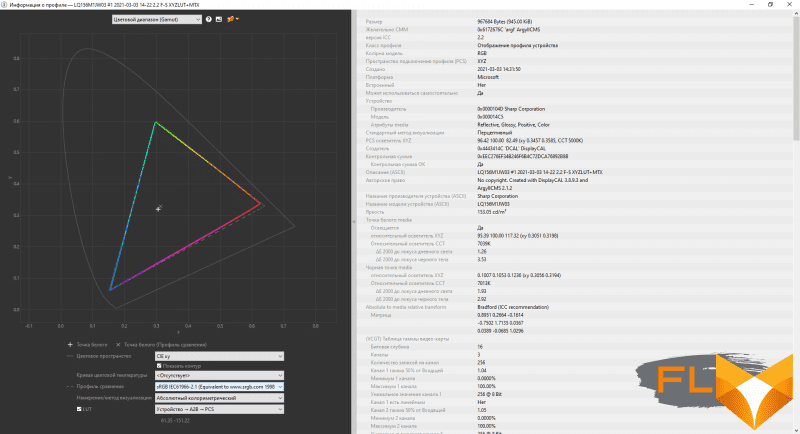
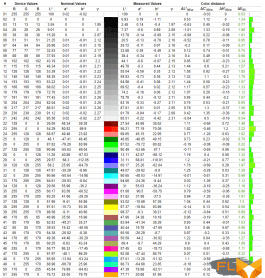 |  | 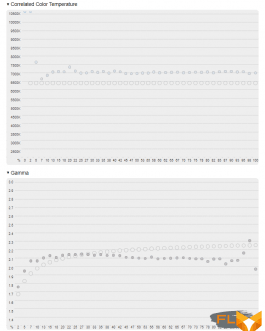 |
As for the sound, here I don’t really have anything to complain about. By laptop standards, the acoustic potential of the GE66 Raider is very good: the bass is clearly audible, and the middle and top do not sag, as is often the case in inexpensive “plastic” laptops.
⇡#Efficiency of the cooling system
You can “play” with the laptop’s operating modes, as always, in the MSI Dragon Center application. In the tables below you can see how the laptop works when using the Extreme Performance and Balanced presets and when the Cooler Boost feature is enabled, which forces the cooler fans to run at maximum speed.
| Summary of laptop operation and setup | |||
| Laptop mode | Extreme Performance | Balanced | Extreme Performance + Cooler Boost |
| Declared GPU Speed (Boost) and Memory Speed | 1620 MHz, 14 Gbps | 1620 MHz, 14 Gbps | 1620 MHz, 14 Gbps |
| Cyberpunk 2077 Real GPU Clock: Min, Max, Average | 1500 MHz | 1470 MHz | 1730 MHz |
| 1950 MHz | 1905 MHz | 1950 MHz | |
| 1559 MHz | 1543 MHz | 1758 MHz | |
| Maximum noise level | 36 dBA | 35.1 dBA | 50.9 dBA |
| Average Power: GPU, CPU | 114W | 111W | 127W |
| 27 W | 26 W | 30W | |
| GPU Temperature: Average, Maximum | 86 °C | 86°C | 66 °C |
| 87 °C | 87 °C | 67 °C | |
| CPU temperature: average, maximum | 84 °C | 82 °C | 66 °C |
| 99 °C | 98 °C | 88 °C | |
| Performance | |||
| 3DMark Time Spy scores | 9770 | 9227 | 10269 |
| 3DMark Fire Strike scores | 21194 | 15684 | 22187 |
| Unigine Superposition, 1080p Extreme, points | 6730 | 6454 | 6890 |
| Extreme Performance Mode | Balanced Mode | Extreme Performance + Cooler Boost |
Notebook case heating (games, nominal operation)
It immediately catches your eye that the laptop is configured for maximum quiet operation – even in Extreme Performance mode, the laptop functions really quietly. Yes, the average temperatures of the processor and graphics go over 80 degrees Celsius, but in fact, playing sitting at the GE66 Raider turns out to be very comfortable – using a headset is completely optional, and the keyboard does not heat up much. At the same time, we see that the inclusion of the Cooler Boost function can significantly reduce the temperature of the chips, while increasing their performance. True, in this mode, it will not work to call the laptop quiet.
Let me draw your attention to the fact that GE66 Raider supports Dynamic Boost 2.0 technology. This means that from now on, the power consumption of the CPU and GPU can constantly change, adjusting to the conditions that provide the maximum FPS in a particular game.
We see that in games that seriously load the GeForce RTX 3070, the maximum power consumption of the graphics chip really reaches the declared 130 W, and then the GPU power changes depending on the conditions (cooler capabilities, for example) and laptop BIOS settings.
As always, MSI engineers make the most of the hardware installed in the laptop. That is why the central processor gets very hot when performing resource-intensive tasks, because its power consumption exceeds the TDP passport level (45 W for the Core i7-10870H). We can see that the PL1 value varies between 70-74 W, but the Extreme Performance mode is configured in such a way that the cooler draws an average of 56 W. In Balanced mode, this figure is noticeably lower – in such conditions, the laptop can be considered cold and almost silent.
| Laptop cooling performance in Adobe Premiere Pro 2020 | |||
| Extreme Performance | Balanced | ||
| CPU frequency | Medium | 3.6 GHz | 2.7 GHz |
| CPU temperature | Maximum | 97 °C | 75 °C |
| Medium | 95 °C | 71 °C | |
| Noise level | Maximum | 36.8 dBA | 35.3 dBA |
| CPU power consumption | Average | 56 W | 30W |
| Test task execution time (less is better) | 843 s | 1056 s | |
| Extreme Performance | Balanced |
⇡#Laptop performance
The release of the GeForce RTX 30 laptop graphics set a rather interesting precedent. As we have already said, from now on there can be several versions of this or that GP. Here in the GE66 Raider, the GeForce RTX 3070 is used, the maximum power of which is 130 watts. But on sale you will find laptops with the same graphics, designed for a maximum of 100, 90 or even 80 watts. I think it is obvious that such laptops, which formally use the same graphics (“GeForce RTX 3070 for laptop”), will have different performance. And sometimes the difference can be huge.
An illustrative example is shown below.
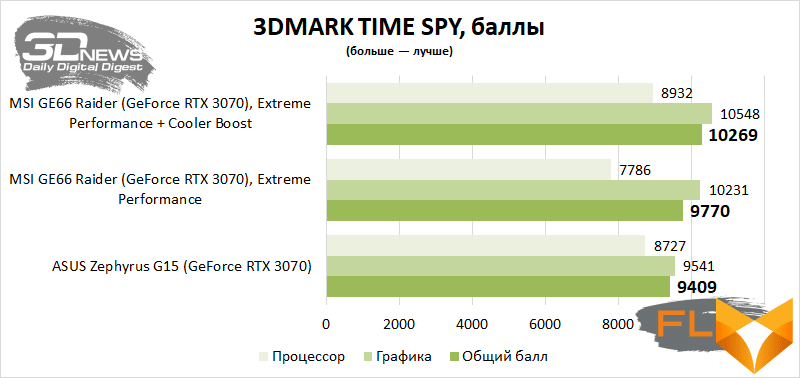
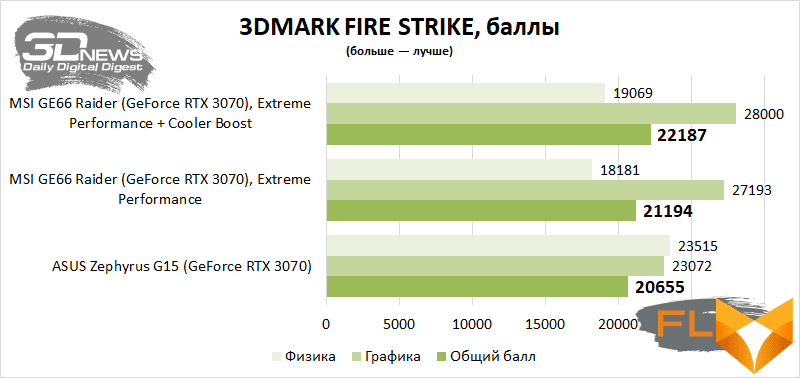

For example, the ASUS Zephyrus G15 also uses the mobile version of the GeForce RTX 3070. The only difference with the GE66 Raider is that the GPU in this laptop has a 100W graphics card power limit. And we see that the GE66 Raider is 3-8% faster in Extreme Performance mode and 7-11% faster with Cooler Boost enabled.
I believe the GE66 Raider will even outperform some gaming laptops with the GeForce RTX 3080 if the NVIDIA flagship processor is “strangled” to 80-90 watts in these models.
Naturally, this state of affairs is confusing – choosing a laptop with Ampere graphics is difficult. Well, the more useful our reviews become.
| Test results in games, Full HD, FPS (more is better) | ||
| MSI GE66 Raider (GeForce RTX 3070 130W) | ||
| AVG | 1% MIN | |
| World of Tanks | 237 | 157 |
| CS:GO | 318 | 113 |
| PlayerUnknown’s Battlegrounds | 123 | 82 |
| The Witcher III: Wild Hunt | 93 | 63 |
| GTA V | 70 | 50 |
| Shadow of the Tomb Raider | 93 | 71 |
| Assassin’s Creed Odyssey | 61 | 45 |
| Red Dead Redemption 2 | 74 | 60 |
| Gears 5 | 80 | 50 |
| Metro: Exodus | 75 | 40 |
| Death Stranding | 130 | 100 |
| A Total War Saga: TROY | 73 | 48 |
| DOOM Eternal | 220 | 175 |
| Horizon Zero Dawn | 90 | 65 |
| Watch Dogs: Legion | 74 | 60 |
| Battlefield V | 100 | 70 |
| Cyberpunk 2077 | 55 | 35 |
The laptop was tested in games in Extreme Performance mode, but we found that turning on the Cooler Boost function will increase FPS by an average of 3%. At the same time, the performance of the GE66 Raider is enough to comfortably play all 17 games used in our testing methodology – and in most cases we are talking about the maximum graphics quality.
The noticeably full-fledged GeForce RTX 3070 accelerates the laptop even when performing resource-intensive tasks.






Below are the results of testing the laptop in the PCMARK10 comprehensive benchmark.
In a number of tests (archiving, working with graphics and photo and video content, interaction with browsers, as well as office applications), the laptop drive plays an important role. The MSI laptop has a Western Digital WDC PC SN730 SSD, which is not the fastest drive by the standards of NVMe models. For example, linear read and write speeds do not exceed 3 GB / s. Random operations are also slow. All this affects the results of testing PCMARK 10, which, as you know, loves fast SSDs.
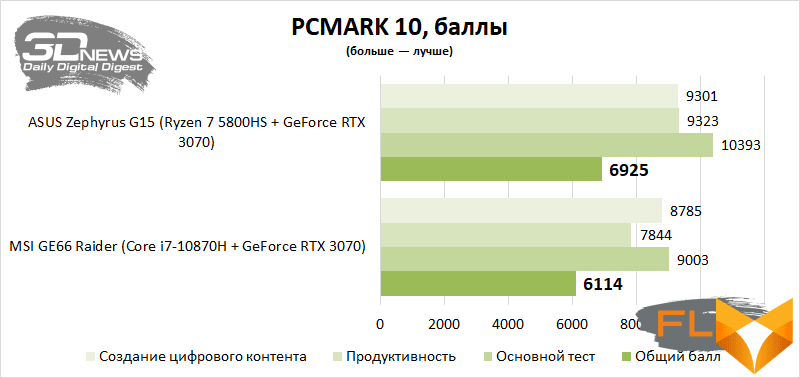
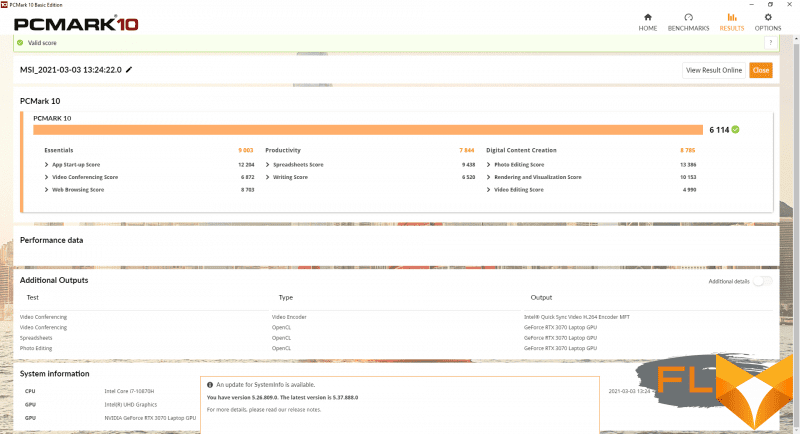
⇡#Laptop offline
The laptop is powered by a 99.9 Wh Li-Ion battery, the maximum battery capacity to take your device on board an aircraft. As you can see, despite this, the MSI GE66 Raider does not break records of autonomy with a display brightness of 200 cd/m2. Nevertheless, we have a very powerful laptop, which in light work scenarios (web surfing, watching videos) works for almost seven hours – this is quite an achievement.
| Battery life, screen brightness 200cd/m2 | |
| Web | 6 hours 58 minutes |
| View video | 6 hours 45 minutes |
⇡#Conclusions
Last year, I praised the MSI GE66 Raider – for good reason. The updated version of the Raider deserves no less warm words, because the key improvement of the laptop, in fact, was the use of the new NVIDIA Ampere graphics. As a result, you have a fairly fast gaming system with an uncut GeForce RTX 3070 for laptops. The performance of such an accelerator is quite enough to play all modern games in Full HD resolution – mainly at the maximum graphics quality.
In addition, the GE66 Raider is equipped with a cool display, a quality keyboard and an excellent set of ports and video outputs. The autonomy of the device – albeit not a record one – will allow you to use it away from home all day. Finally, the Raider has good storage upgrade capabilities.
Yes, while the MSI GE 66 Raider, even in the younger modification, cannot be called cheap, but models with GeForce RTX 2080 SUPER class graphics used to cost under $3,100 before.
